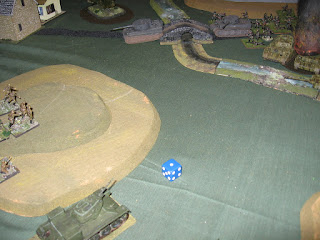Divisional HQ has decided on probing attacks to uncover weaknesses in the enemy defences while capturing important local objectives. Two infantry battalions, with limited support, are to conduct the attacks. The third battalion of the brigade remains in reserve and is not available for today's operation.
So says the introduction to Keith McNelly's 'Battalion Advance' scenario. Nick and I had a shortened afternoon available to play a 20mm Spearhead game, and this looked like a good sized game to tackle. The scenario is set up to be played on a 4'x3' table with normal SH scale, so we expanded it onto a 6'x4' table using the 1.5 x ground scale. Nick took the British attackers, and I took the German defenders. This is a brief account of the action. The photos are generally taken with a view from behind the German lines.
The British attack came from the top of the photo. Nick opted to focus on his left flank (advancing along the right side of the photo, attacking the German right flank), the first battalion advancing on foot. The second, with armour attached, sat off table in reserve per the scenario option.
The Germans were entrenched.
The advance under way, with Nick having decided to commit his reserve early, seen here entering the table behind the first battalion, complete with armour. He concentrated his entire attack on his left, the German right.
First contact, the British advance comes under mortar fire.
I opted to keep the two StuGIIIs as my two hidden stands. The first was revealed, in its hull down position in the centre of the ridge line that defines the battlefield, as the British armour crossed its front. The first Sherman was brewed up from a long range shot.
With the focus of the British thrust now apparent, the German left wing German defending platoons advanced across towards their right, hoping to catch the British attackers in flank and rear.
Action is joined between the German right flank defenders, well dug in on the edge of the woods, and the British attackers swinging wide around their flank.
The one sided armoured duel was short lived, but the lone StuG took out the Firefly before the British armour passed from view behind the terrain.
The perilous position on the German right is apparent here when the strength of the British thrust around the German right flank is seen.
And so they continued to sweep around the flank towards the town sector.
With the flank attack capturing the town, the first of the two British armoured platoons moves on past the town, to discover not only the first StuG platoon that had engaged them from long range, but also the second StuG platoon. Oh!!!!
The Sherman platoon is suppressed ..
British infantry close assault some of the German defenders, but are repulsed.
We ran out of time after nine turns, and Nick conceded the game, as casualties had mounted to 11 stands, with only two of the 4 necessary objectives in his hands.
So what was the verdict? This is a scenario I've looked at several times, and perhaps dismissed as a little too small.
Well fool, me! This is an excellent scenario, challenging to both sides. Nick's plan was a good one. His only downfall was in the use of his artillery. He tried to shell the German defenders out of their entrenchments, too hard an ask for the small 25pdrs. More judicious use of smoke might have allowed for his well executed sweeping flank attack to get behind the German positions with far fewer casualties. Had he done so, he still had plenty of moves in hand to capture his objectives and win the game.
Again here is Nick's AAR.










































